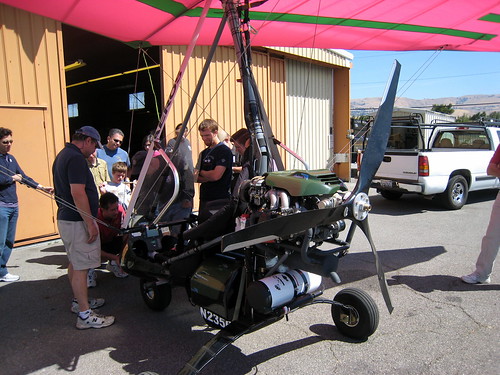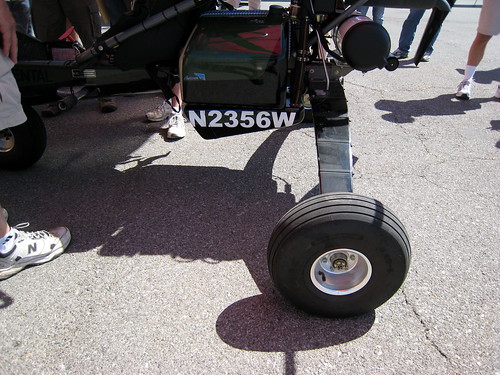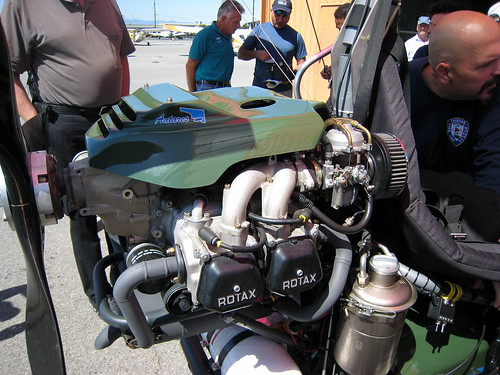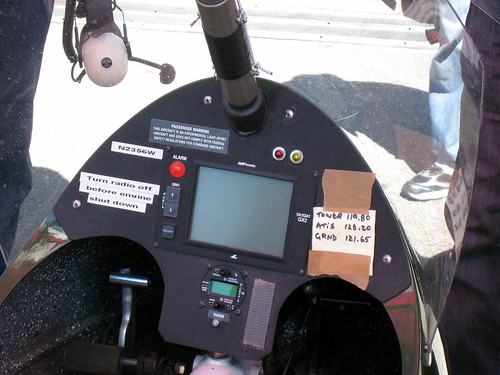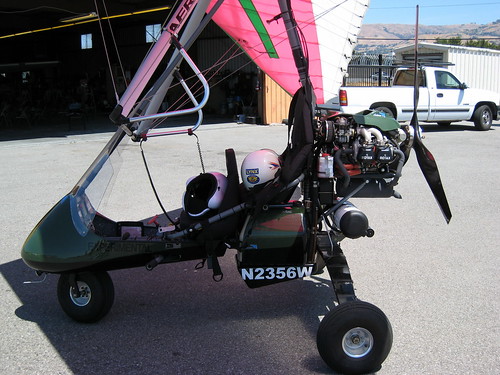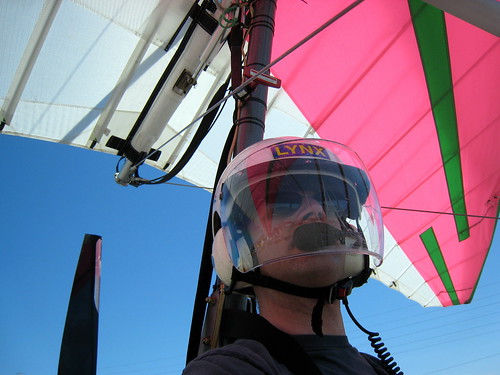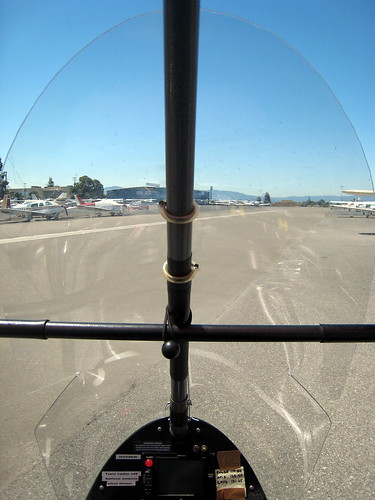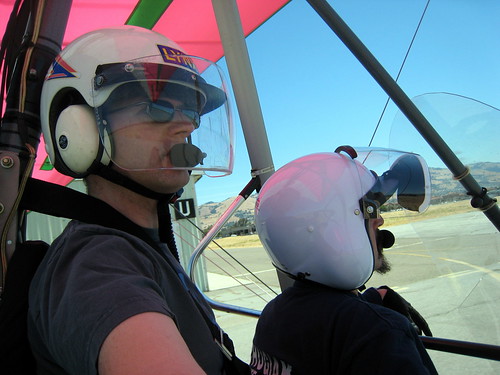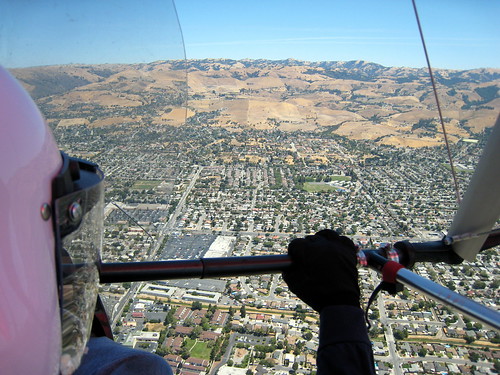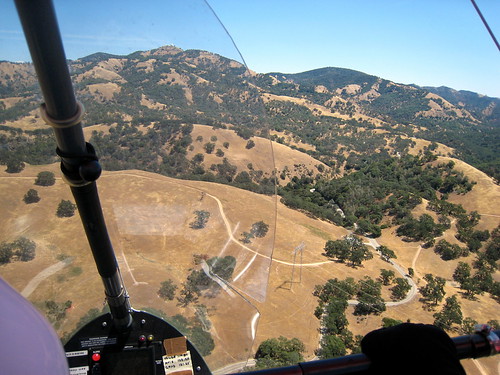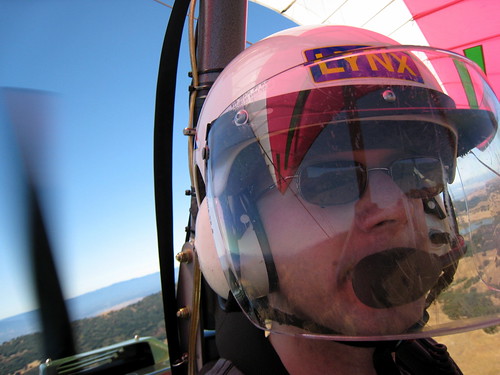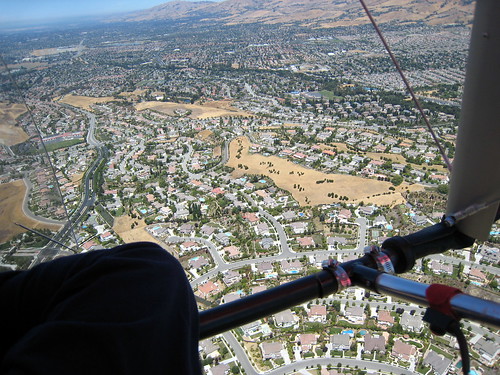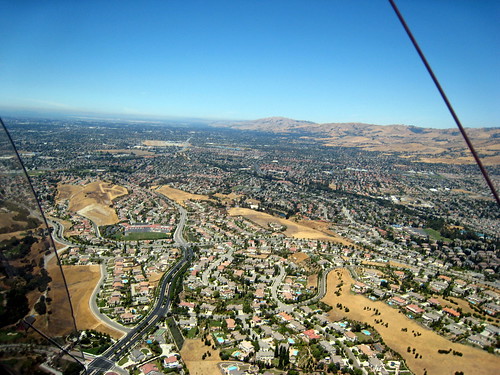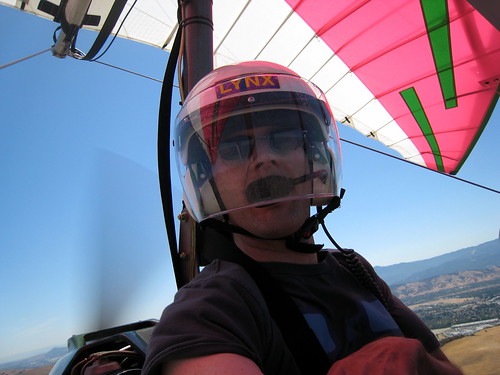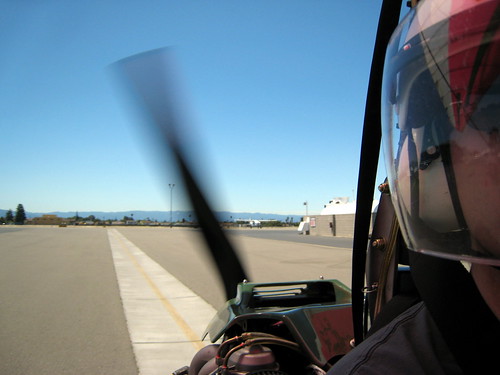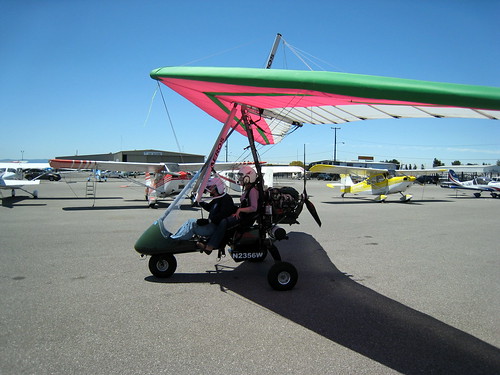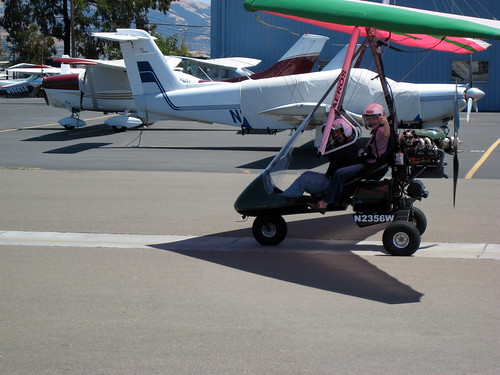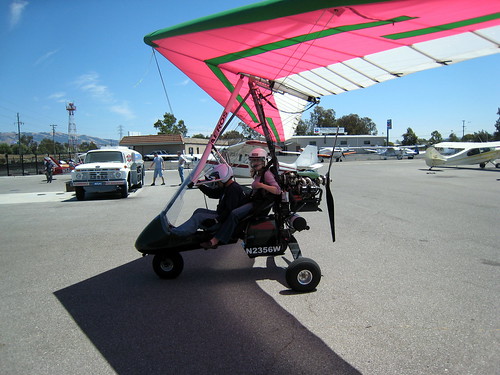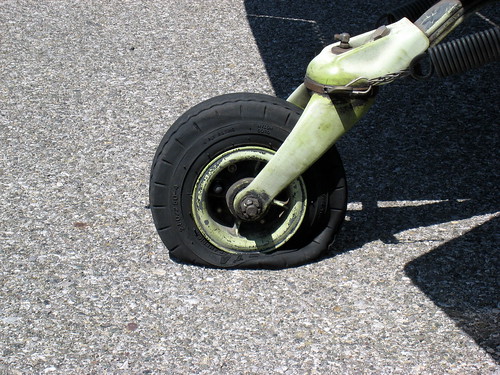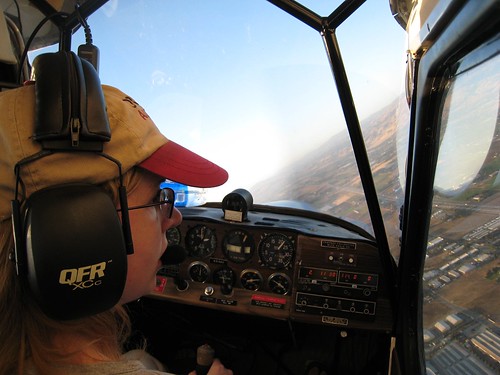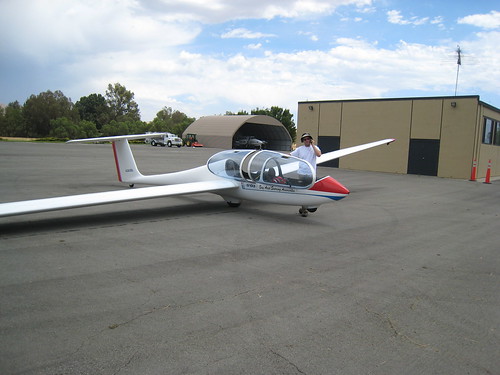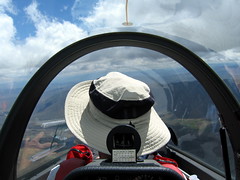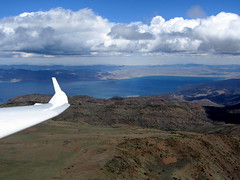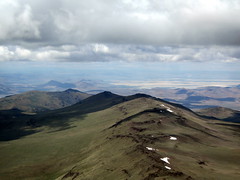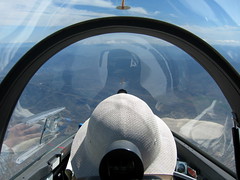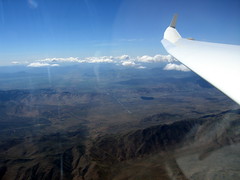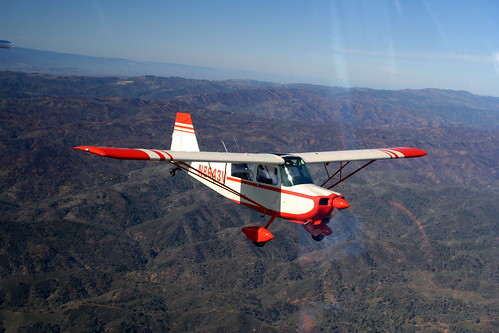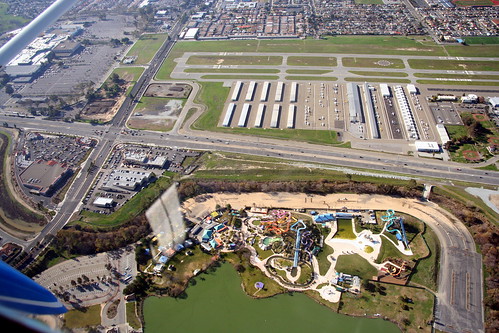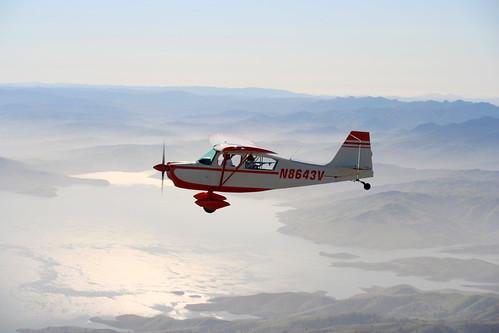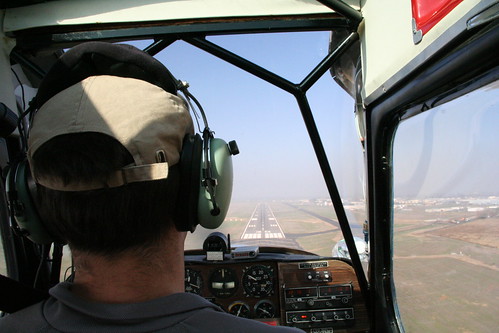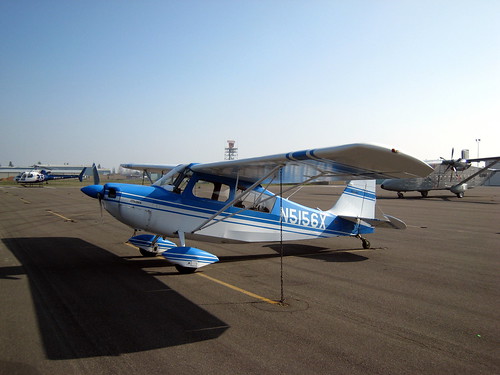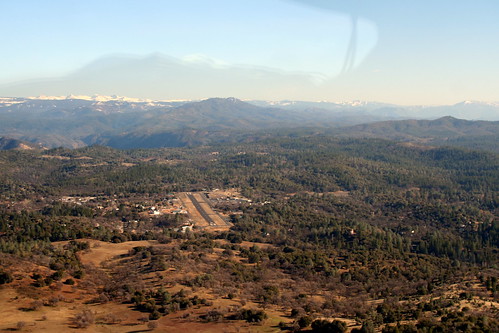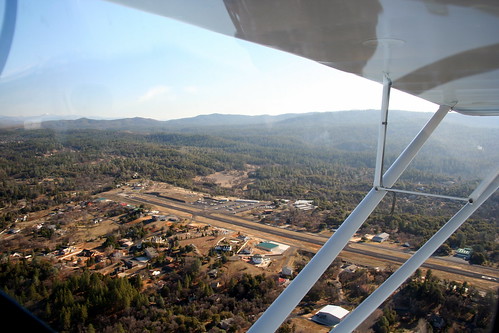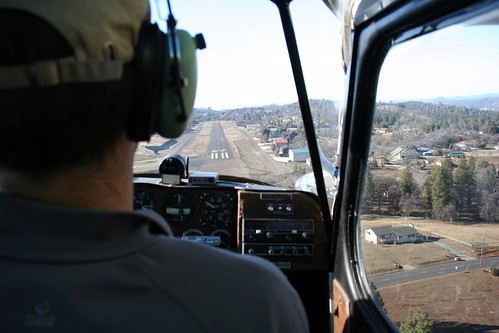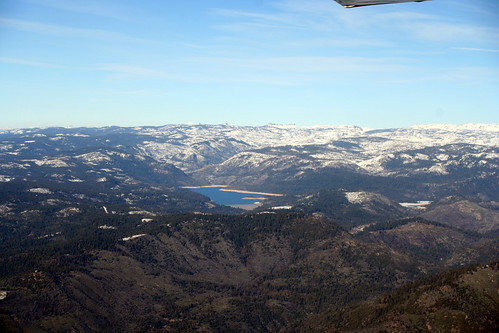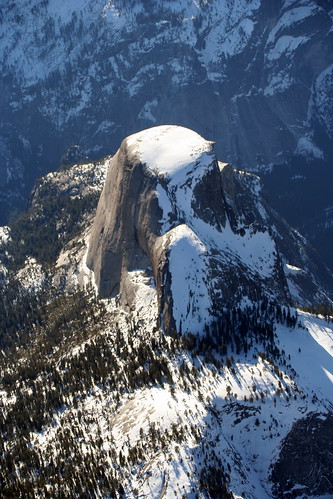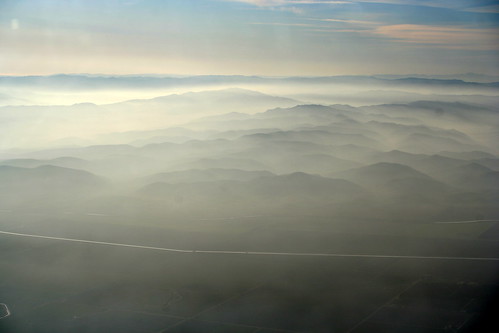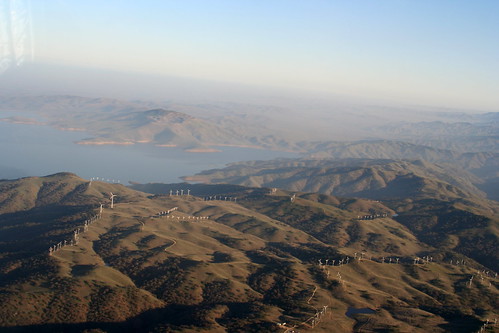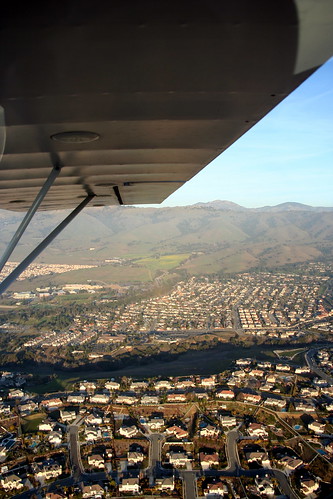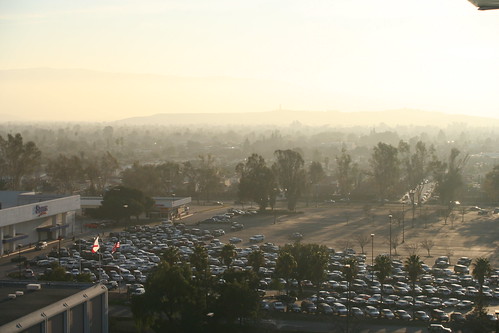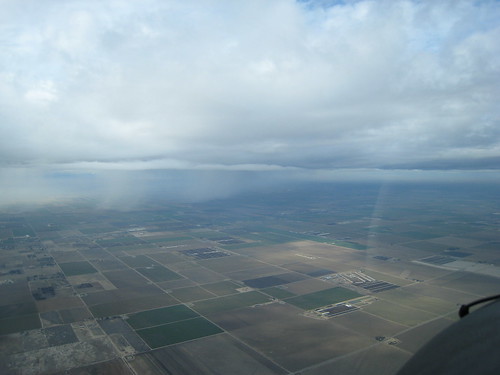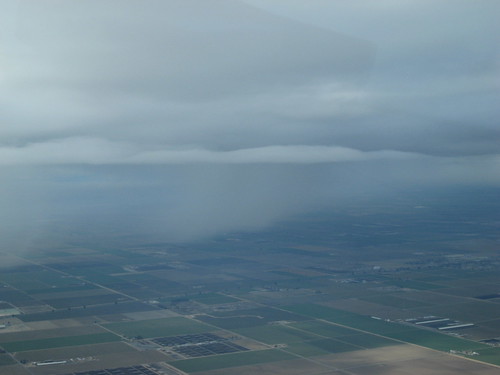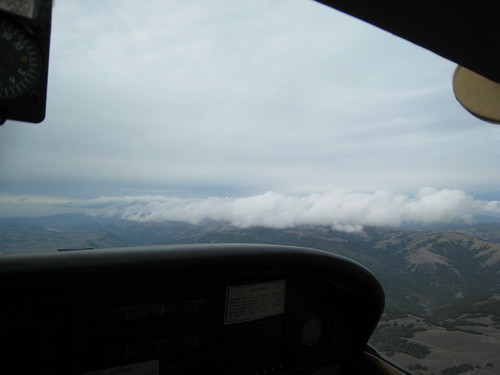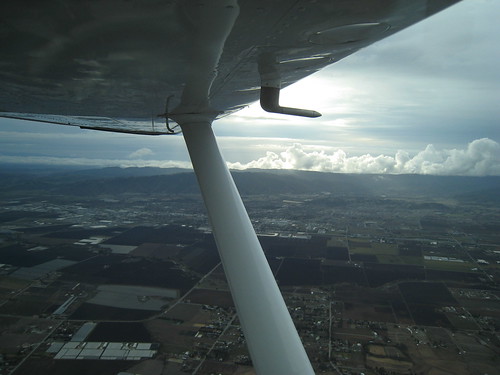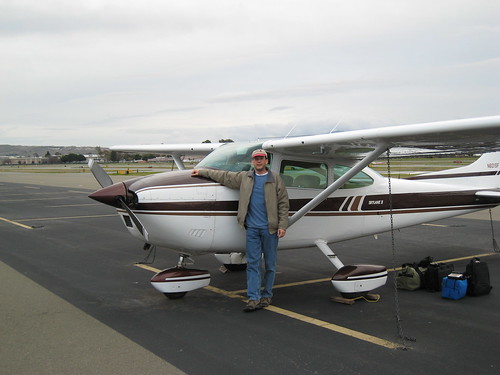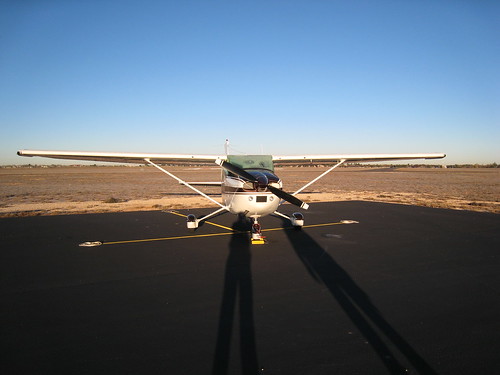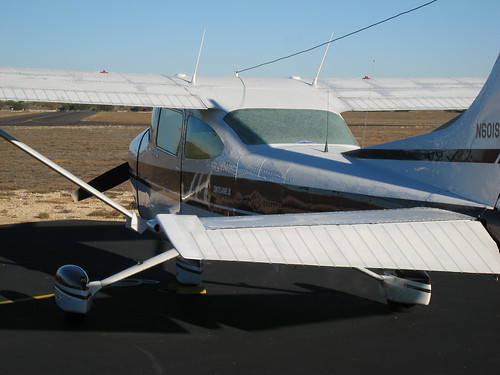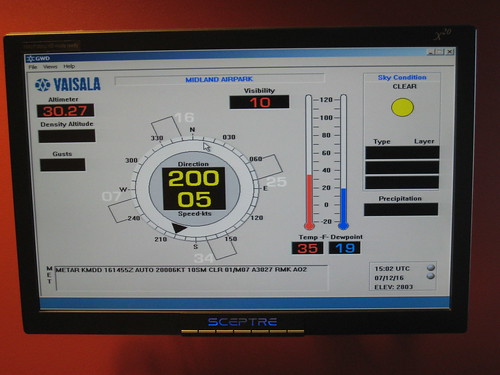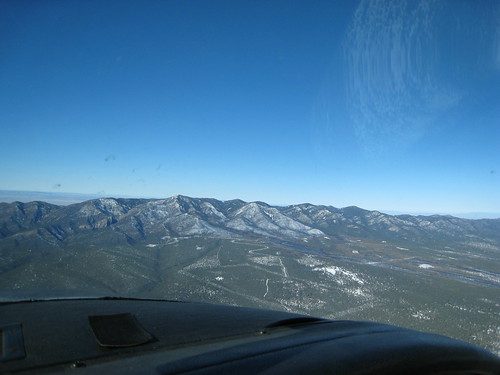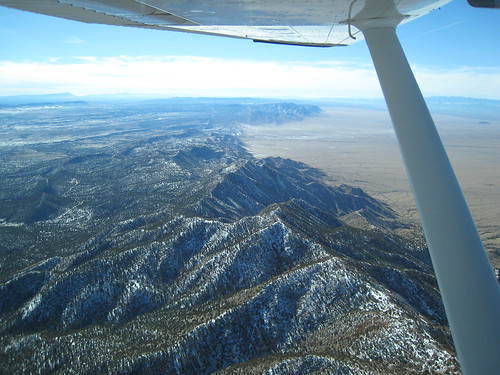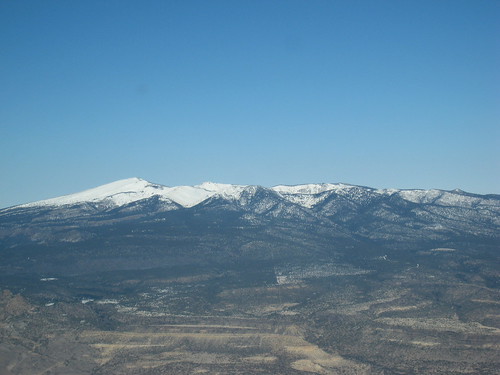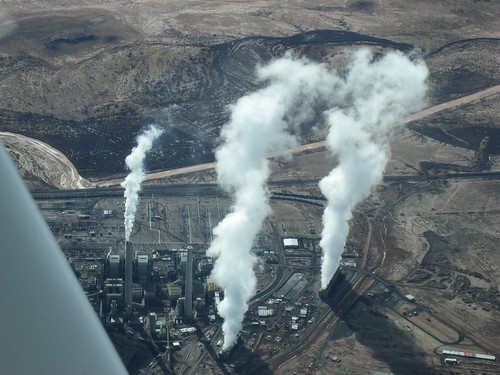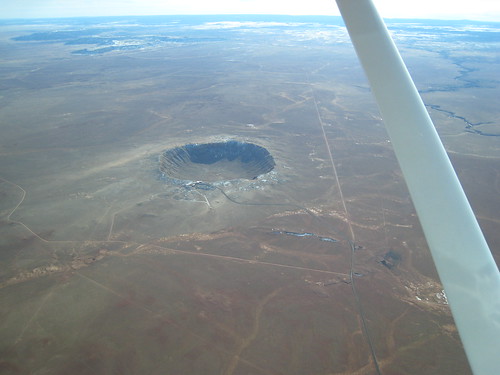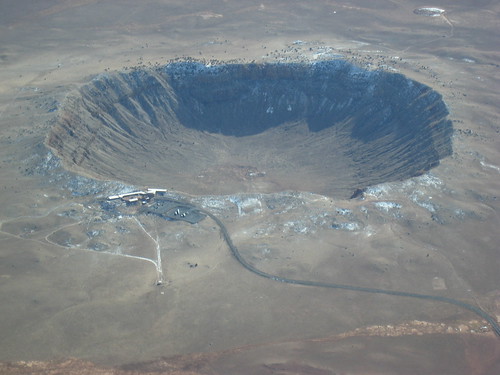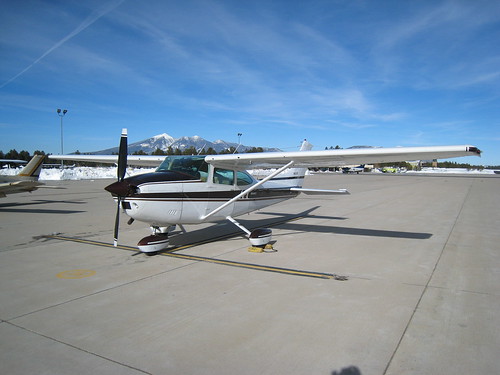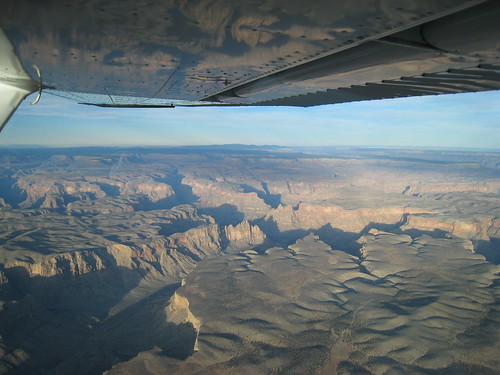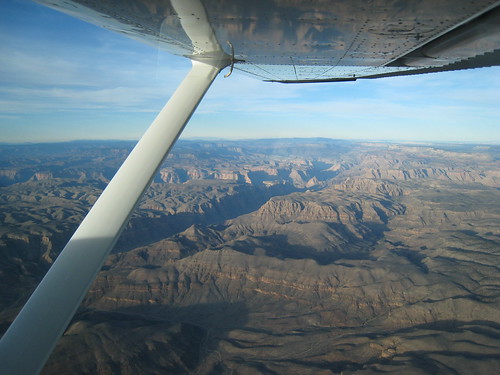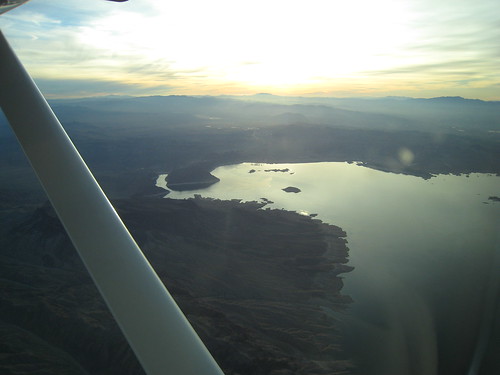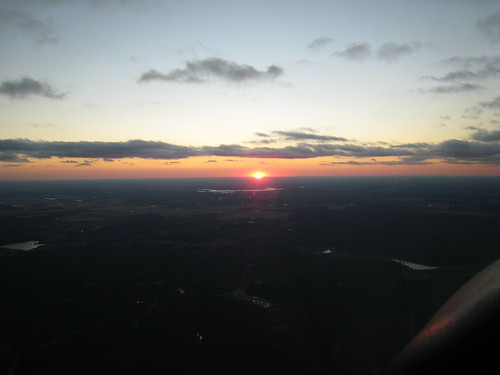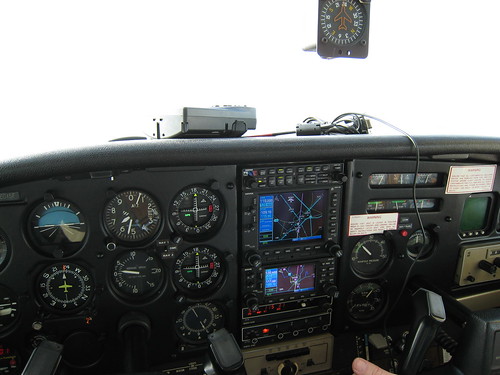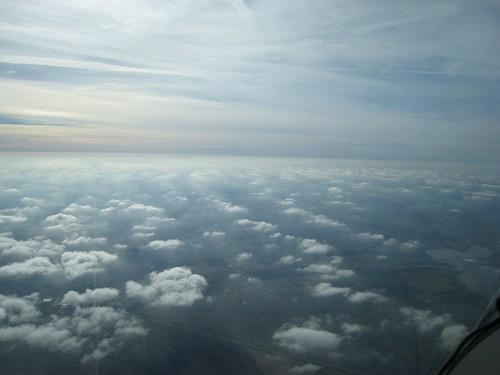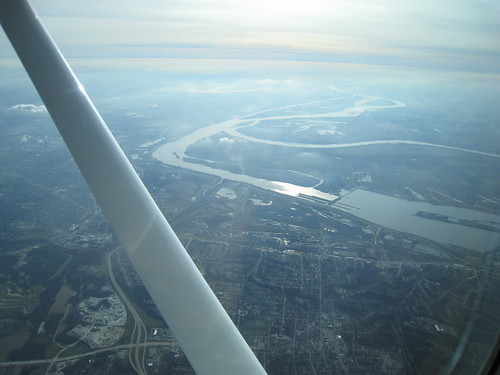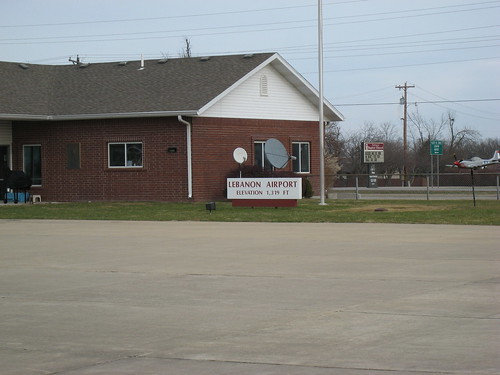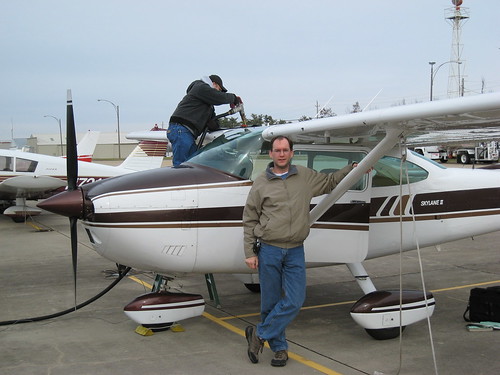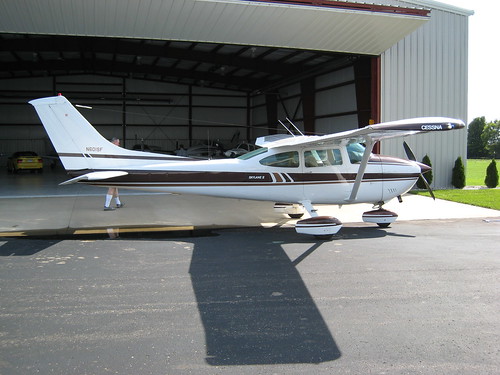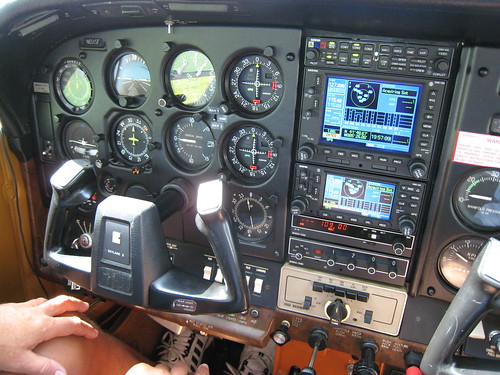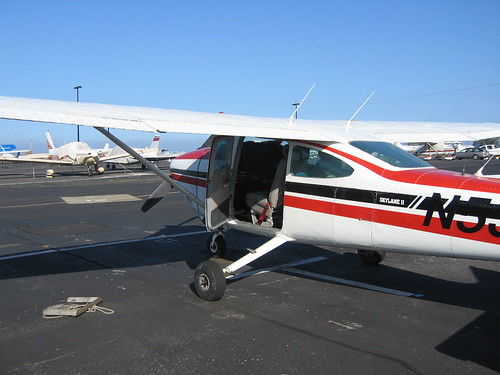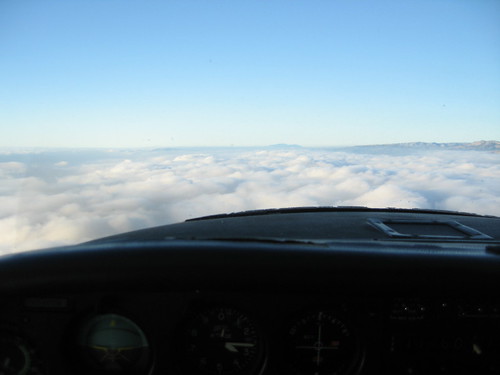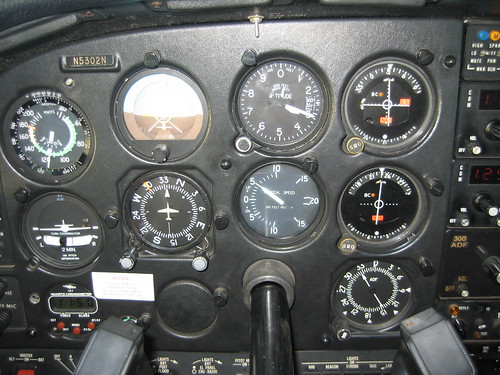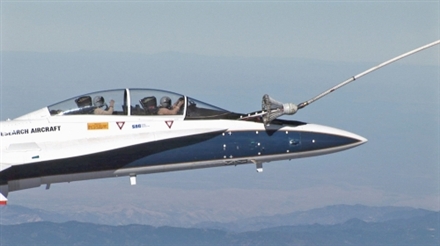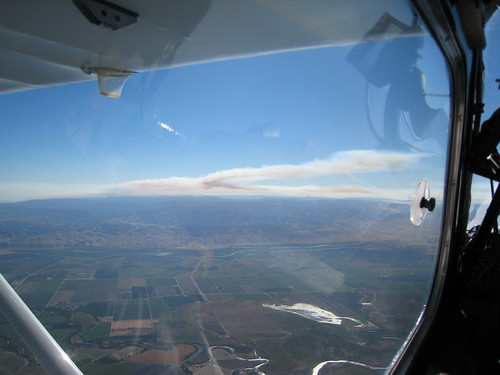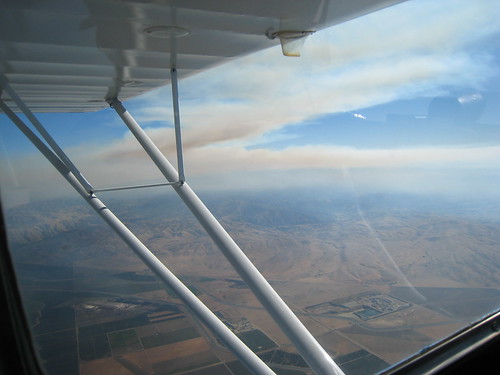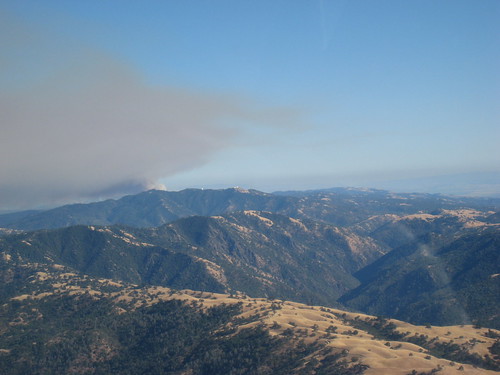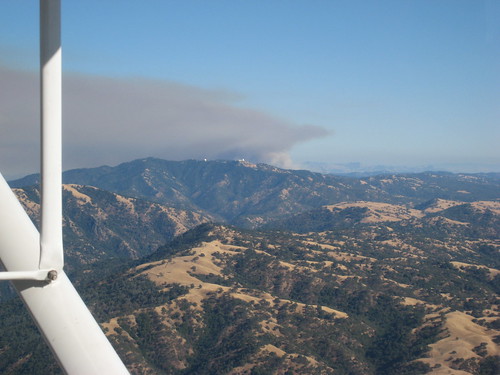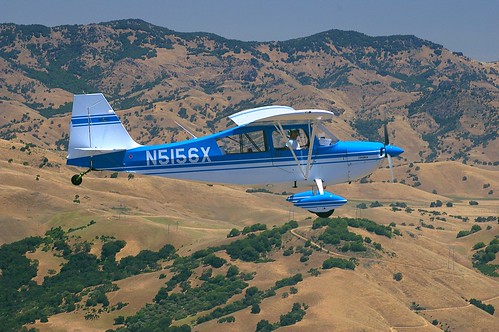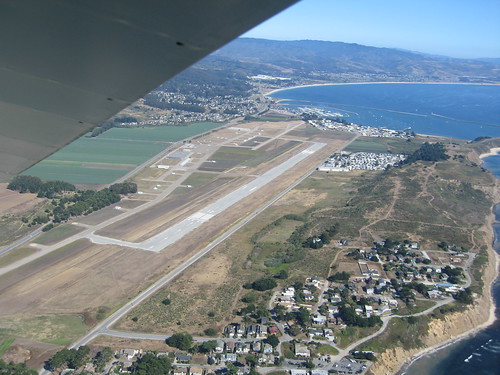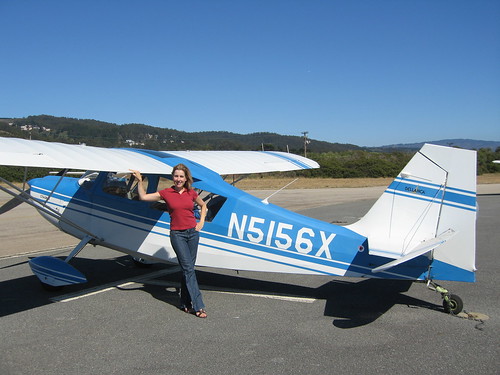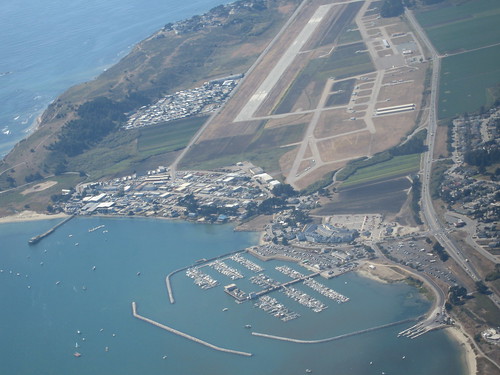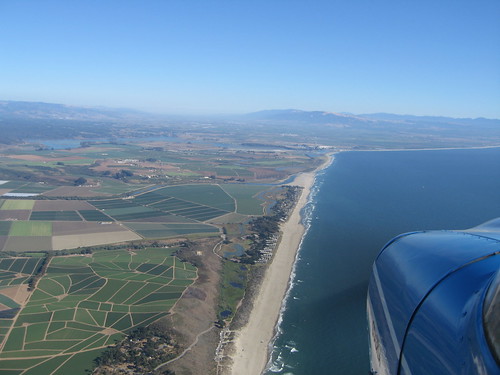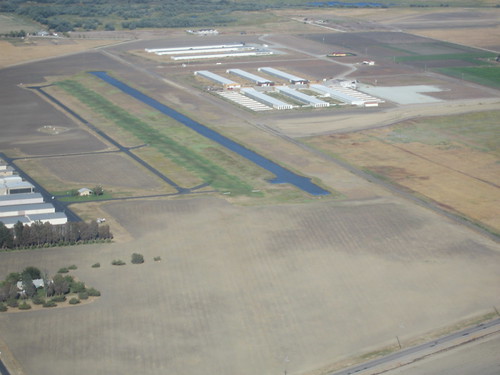August 02, 2009
Flying an Ultralight Trike or Weight Shift Control Aircraft
On Saturday Kathleen and I took advantage of the chance to take a short class in Trike flying and then go up for introductory rides.
This was an event organized by AreoDynamic Aviation (formerly Amelia Reid Aviation) at the Reid-Hillview Airport in San Jose.
We arrived to find Pete Marsh's Antares MA-34 R912 Ranger with an 80 horsepower Rotax 912 engine sitting outside the hangar. So I took several photos of the engine, cockpit, and wing while we got a good look at it.
After checking it out, Pete spent about an hour telling our class about Trike flying in Alaska, answering our questions about the sport and the machines, and giving us a little bit of an idea what to expect.
For the record, this Trike has electric trim and will cruise at about 70-75mph while burning 2.5 gallons of high octane auto gas per hour. So mileage is comparable to most cars. But the ride is a hell of a lot more fun! And with a 15 gallon fuel supply, you can fly a lot longer than your bladder will let you.
Several of us had reserved times to fly 1 hour $99 introductory rides with Pete, and before I knew it my time had arrived. I was really looking forward to the experience.
Pete helped me get strapped in and I took a few pictures and a vide as we taxied over to the run-up area for runway 31R.
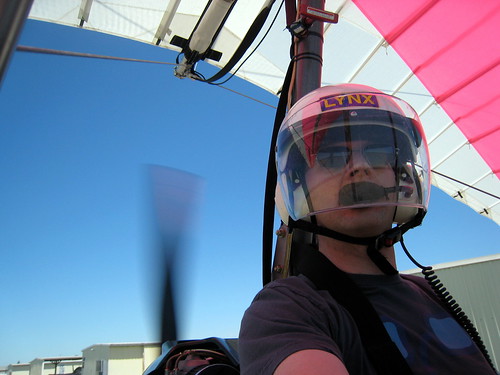
Engine running and we're taxiing!
Here's a short taxi video:
After a couple other departures, we were cleared to take off!
Takeoff video:
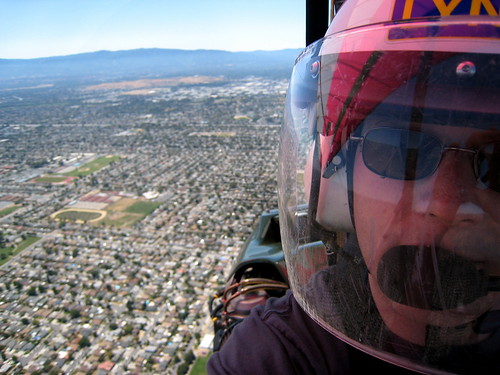
Look, Ma. I'm flying the Trike!
And before I knew it we were in the air and flying.
The first few seconds were kid of freaky, given how open the cockpit is. But that quickly faded away and I began to really enjoy the flying. We headed a bit south and then over the first ridge toward the Lick Observatory on Mount Hamilton where we could play around a bit and I could get a better feel for flying the Trike.
Back there I got to try various flight maneuvers, really get a feel for the air, and even did some soaring in thermals. I was really impressed by how well we could feel the air as the wing tried to move and the distinct changes in temperature as we flew into different pockets.
Turns were easy once I got over the idea of forcing them. We also performed a few stalls (though they hardly compare to stalls in a larger airplane or glider)--very benign. I was impressed by how stable the aircraft was too. Let go and it'll pretty much fly straight and level if you're in calm air.
The view was, of course, amazing. And being able "feel" the air more directly makes you feel a lot more connected to the atmosphere you're flying in.
All in all it was a much more "raw" experience then the glider flying I'm used to. I really enjoyed it.
After almost an hour of flying, it was time to head back in and land.
Landing video:
After landing, we taxied back to the hangar so that Pete could pick up his next victim passenger.
Next up was Kathleen...
The took for for a similarly fun 1-hour flight.
Takeoff video:
I was there to grab a few pictures as the taxied back to the hangar area.
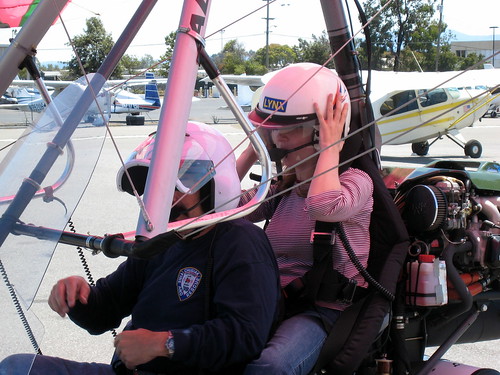
Time to let someone else play...
Conclusion
We both had an absolute blast flying the trike. It's a little like flying a power plane and a little like flying a glider, but it's a very different experience from both. It's a very raw and natural form of flying that really puts you in touch with your surroundings and gives you an amazing view of the area you're flying in.
Thanks again to AeroDynamic Aviation for organizing this event. Not only do they provide excellent flight training and aircraft maintenance, Owner Zdravko Podolski has consistently organized events to help pilots expand our flying horizons.
We're both very tempted to get a weight-shift control add-on for our pilot certificates. It's worth noting that many Trikes make it easy to swap out the wheels on the landing gear for floats (land on lakes!) or skis (land on snow/ice).
Pictures and Video
I have the whole set in this Picasa album: Trike Flying at RHV
Or you can see a subset in my Trike Flying album on Flickr.
The videos are in my YouTube channel as well.
July 27, 2009
Loose Fuel Cap and Losing Fuel In-Flight (with Video)
While our flying trip to Yellowstone and the Grand Tetons was great, we had a few problems along the way. Like they say, bad things often come in groups of three. This was our third one. (The other two involved a hiding cat and a blown tail wheel on the airplane).
On our way home Saturday, we flew from Jackson, Wyoming (JAC) to Burley, Idaho (BYI) to get a bit of fuel, grab a snack, and take a restroom break. A few minutes in the air after leaving Burley, Kathleen looked back at the left wing and saw fuel streaming back. And it didn't seem to stop. Uh oh!
She shot this video.
We were closer to Twin Falls (TWF) at this point, so I called up the tower and began our descent down from 9,000 feet to land and check it out. We fully expected the fuel cap to be completely missing. Unlike the fuel caps on a Cessna, there is no chain that keeps it connected to the fuel tank. So if the cap comes off in flight (or was never put back on), you've lost it.
The tower cleared us for a straight-in on runway 25 and we landed shortly after a Turbo Ag Cat came in on the opposite runway.
We landed, taxied over to the full service fuel and FBO, and parked. I borrowed a a bucket (no ladder handy) from the guy who came over, climbed up, and was astonished to find the fuel cap was there and it felt tight!
There are two flanges on the fuel cap that serve to lock it to the neck of the fuel tank. Normally both of them are fitted tightly below the rim. But the guy who fueled it in Burley manage to put the cap on in such a way that only one of the two flanges was engaged below the rim.
When I pulled up on the back of the fuel cap, there was enough play to allow fuel to escape in flight when there's a substantial vacuum created by the airflow.
New lesson learned: Always pull up on the fuel cap to make sure it's on tight. Simply making sure that it won't turn anymore is not sufficient.
But that's not all!
With the situation apparently resolved, I got back in, started up the plane, and called up the ground controller. We were told to Taxi to runway 07 for a southbound departure. As we made our way over, I told Kathleen that I was expecting half the fuel we took on at Burley to be gone. But that was okay, since were could land and fuel up in Elko, Nevada (EKO) which was along our route of flight.
We got our takeoff clearance, took off, and departed the area to the south. About five miles from the airport, I glanced up at the fuel gauges and was shocked to see that the left tank was reading close to 1/4 and the right was reading 1/2. Normally I trust the right tank to be very accurate and doubt the left. But I haven't had enough time flying with it since the right tank was repaired, so I didn't really know how much fuel we had.
It didn't take more than a minute to decide that we had to land back at Twin Falls again and top off the tanks before continuing home.
Lesson #2 learned: Always check the fuel level after spewing gas in flight. It comes out a lot faster than you think (as confirmed by our mechanic later that evening).
In better news, we have a ton a great photos and video from our trip. Those should be coming on-line before too long.
March 19, 2009
Aircraft Insurance Surprise
I haven't flown my glider much in the last year and probably won't be flying it again for many months. While that may not be ideal, it means I can spend less money by not paying for an annual inspection and can greatly reduce or eliminate the insurance costs. Or so I thought.
It just so happens that my insurance carrier emailed the other day to ask about renewing my policy (it's that time of year). I explained that I probably wouldn't be flying it and would probably let the policy lapse. The countered with an offer of "storage only" or "ground" coverage, which means that they'd still insure it for non-flight related damage.
Now gliders are kind of expensive to insure in the first place. The annual insurance bill is roughly the same as it is for our Cessna 182Q (which is worth twice as much as my glider). So I was looking forward to paying a lot less.
Wrong!
It turns out that moving to storage only coverage still costs roughly 67% (2/3rds) of what the full flight coverage is. I'm still trying to process that figure. That's like State Farm Insurance telling me that if I agree to keep my car in the garage for a year, they'll give me a 33% discount.
Apparently, (1) there is a lot of overhead in the insurance industry, and (2) they think I'm far more likely to encounter non-flying damage.
And, the best part is this... If I were to cancel coverage all together for the year, I'd have higher rates when I come back next year because of discounts I've accrued with them. "If you let this policy go and then come back later, the new policy offered will be about 15% higher in cost just due to the loss of those discounts." Strangely, I thought those discounts were the result of earning additional ratings (like my Commercial) and gaining experience and flight time.
It's no surprise that the first four letters of the insurance company most glider pilots use are "Cost", huh?
October 07, 2008
Back Seat Flying in the Citabria: Tailwheel Fun
About a week ago I finally got the chance to work on the back seat flying with my instructor in our Citabria. I'm not new to flying from the back. I've done so in gliders for a few years now, but I knew this was going to be a bit different.
I wasn't concerned about the actual flying. Flying is pretty much the same no matter where you are. The only question is how many of the instruments you can see from the rear seat. Luckily, I found that I was usually able to see the two or three that mattered: airpseed, altimeter, and engine RPM.
What I knew would be the most interested was the takeoff and landing--especially the landings. Being a tailwheel airplane, the nose is naturally much higher when on the ground or in a landing attitude. That means dramatically restricted visibility from the back. On takeoff it's not too bad, since you can pretty quickly get the tail flying and level out the airplane.
On landing, however, you end up using a lot of peripheral vision and a bit of faith. (This is assuming a normal three-point instead of a wheel landing. See also: Conventional Landing Gear).
But a funny thing happens after you practice it a few times: you start to get the hang of it and realize that it's not all that different than landing from the front seat. You're still trying to stay lined up on the runway and fly the airplane until it lands. In fact, you're trying to keep it from landing as long as you can so that when it finally touches down there's not enough energy for it to start flying again.
Aside from the satisfaction of learning something new and building confidence in flying your airplane, being able to fly from the back seat has another benefit.
You can now have your wife fly from the font seat and get used to the airplane that she'll be using to finish up her training too. And I may be biased, but I think she did a pretty darn good job on her first flight from the front seat. :-)
I'm not sure I'd want to put a non-pilot up front--or at least not someone who hasn't been around airplanes a lot. There are a some controls that I cannot reach from the rear. But I'd feel pretty comfortable giving rides from the back now.
October 02, 2008
Steve Fossett Wreckage in Mammoth Lakes Area
Various news sources are reporting that Steve Fossett's wreckage has been found in the vicinity of Mammoth Lakes, California. There are a few interesting bits about what I've heard and read so far, but first have a look at the terrain that area.
View Larger Map
There are ski runs nearby and the crest of the Sierra Nevada mountains isn't far either. The Mammoth Yosemite Airport sits at an elevation of 7,128 feet and the nearby ridges and peaks easily top 10,000.
In fact, the impact appears to have happen around 10,000 feet and was consistent with flying directly into terrain. The fuselage apparently disintegrated and the engine was found several hundred feet from the impact location.
My suspicion is that Steve had some sort of in-flight medical problem. He was a very experienced pilot and likely wouldn't have been doing any acro at that altitude (though is plane probably could have). And even if there was engine trouble, he'd have had the sense to try to get it down safely or at least slowly.
The NTSB should be able to figure out if the engine was running at the time of impact. But first they have to get all the wreckage transported to somewhere it can be studied.
The other puzzling thing is that he was supposed to be out look at dry lakes. There aren't really any dry lakes up there. Maybe 15-30 minutes away, down in the Owens Valley and beyond, but not up near the Sierra Crest.
I'm curious to hear what the NTSB and FAA are able to figure from all of this.
July 04, 2008
First Flight of Cirrus The Jet

Given the reputation that Cirrus Design has created for itself, "The Jet" is a highly anticipated jet. The all-new design should appeal to pilots of existing Cirrus aircraft looking to upgrade, as well as those currently flying aging twins which have high operating costs and slower cruise speeds.
AVweb covered the story in this video and this article.
The video is included below.
It'll be interesting to see if they're able to hit all the price and performance targets they set out at the beginning of The Jet development. In the meantime, anyone have $1.5 million I can borrow to get one? :-)
It occurs to me that there's a lot of development and excitement on both ends of the general aviation (GA) spectrum: light sport aircraft on the low end and VLJs on the high end. Hopefully fuel prices don't cut too deeply.
July 03, 2008
A Day of Glider Extremes
A couple weekends ago we experienced a pair of glider extremes at Hollister on Saturday: one very short flight and one very long flight.
The short one, unfortunately, was us. Kathleen and I headed down to fly the BASA Grob 103 on what was predicted to be an epic soaring day. And it was. Unfortunately, we got there a bit late and the weather had already developed quite a bit more than we expected.
We towed toward the east hills and got off around 6,000 feet in what seemed like decent lift. But it was hard to stay with it and the high clouds from over-development in the Santa Cruz Mountains were quickly spreading. That blocked out the majority of sunlight and shut down most of the lift. We quickly went from "wow, this is going to be a good day" to "gee, let's see if we can find enough lift to keep from having to land soon."
Before long, we were getting low and had to head back to the airport. But there was one big a problem. A wall of clouds and rain was approaching from the west and brought a wall of dust on the ground to match. There was a very visible gust front headed directly toward the airport. Folks on the radio were advising pilots to stay away because of the 30 knot crosswind.
We were getting so low at that point that I didn't like the idea of flying back through possible sink and a definite headwind just to land at an unsafe airport. Luckily we were just a few miles from the private Christensen airport, so I put the nose down and headed straight to the runway at maneuvering speed (Va). No pattern. I knew where the wind was and decided to land downhill but into the wind.
All the the while, we were watching lightning strikes in the Santa Cruz Mountains from the approaching storm--some of which started a few of the 1,000+ wild fires that have burned so much of the California countryside.
Anyway, before long we were on the ground and sitting in the glider while the storms passed. And after the fun passed, I got on the phone to call for a retrieve.
This goes down in my book as my shortest (distance and time) cross country flight. Ever.
*sigh*
More pictures available in my Christensen Landout on Flickr.
And for something completely different...
In related but much better news, Hollister glider pilot Eric Rupp set a new distance record the same day, flying his DG-300 glider from Hollister to Calexico, California--right on the Mexico border. This amazing 782.66 kilometer flight has been the subject of much planning and speculation until Eric finally pulled it off. It was an amazing combination of great weather, timing, and piloting.
You can see flight details on OLC and his SPOT Satellite Messenger kept the rest of us informed on the ground while he was flying.
Eric's epic flight was covered a bit in the press as well:
- Bay Area glider makes record-breaking flight to Mexico - Santa Cruz Sentinel
- 444 Miles Of Non-Powered Flight - AVweb
Congrats to Eric on an amazing and inspiring flight.
June 10, 2008
The 2008 Air Sailing Cross Country Camp
Last week, as with the previous several years, I spent some time away from work to attend the Air Sailing Cross Country Camp (see events) in Nevada. That's a week long educational camp for glider pilots who are looking to expand their soaring horizons beyond the reach of their local airport.
I attended four years ago as a participant and have been going back every year since then as a "lead pilot" or mentor to the participants. The weather conditions are different every year and we have a different crowd of people attending, but we always have educational classes in the morning and some fun flying in the afternoon.
This year, however, was a bit different, since Kathleen (my wife) was one of the participants. And as luck would have it, I got to be her lead pilot. We were fortunate to fly on three different occasions in the BASA DG-1000 (N451CH).
I happened to have my camera handy for two of those three flights and have the pictures on my Flickr photostream in two different sets. The first was on Tuesday when we had the chance to do some ridge soaring: DG-1000 Ridge Flying at Air Sailing. Here are a few shots.
The second set is from Friday when we flew from Air Sailing to the Truckee Tahoe airport so that we wouldn't have to disassemble the glider and trailer it there: DG-1000 from ASI to TRK. Here are a few shots.
I also have GPS traces from each flight and some great 3-D animated playbacks that give you a sense of our flight paths. I'm working to convert those into movies I can stick online here too.
See Also:
- First 5.5 Hour Flight out of Air Sailing (2004)
- In the Nevada Desert for a Week... (2004)
- For My 31st Birthday: Long Flight and a Smaller Version of Me (2005)
May 29, 2008
Death of the $100 Hamburger
With aviation fuel (avgas or 100LL as we like to call it) climbing over $5.50/gallon in many areas (see 100LL.com for current prices), it's clear that the famed $100 Hamburger is rapidly vanishing from aviation.
If you're not familiar with the concept, Wikipedia explains it well:
A $100 Hamburger is aviation slang for a private general aviation flight for the sole purpose of dining at a non-local airport. Most often used by pilots who are looking for any excuse to fly, a $100 hamburger trip usually involves flying a short distance (less than two hours), eating at an airport restaurant, and flying home. "$100" originally referred to the approximate cost of renting or operating a light general aviation aircraft, such as a Cessna 172, for the time it took to fly round-trip to a nearby airport. Increasing fuel prices have since caused an increase in hourly operating costs for most airplanes, whether rented or owned.
The last time we flew for a $100 hamburger was back in January when a group of group of us (two Citabrias, one Cub, and one Cessna 150) headed out to Merced for lunch.
I actually did have a burger that day. :-)
But when your airplane burns 6.5 gallons/hour (leaned) and fuel is $5.50/gallon, you can't fly much more than an hour each way and keep it to $100 (not including food, maintenance, or insurance!).
The only I hope I see is that many of the new Light Sport Airplanes are using engines that burn anywhere from 3.5 to 5.0 gallons of fuel per hour. That's an improvement.
In The $200 hamburger, Nate Ferguson at AOPA Pilot suggests that we need to increase that number. He's definitely right, but something about calling it a $200 Hamburger really spoils it for me.
April 29, 2008
Quasar Fuel Efficient Light Sport Airplane
According to this AVweb story, a Brazilian-made light sport aircraft could set records for fuel efficiency if it lives up to claims.
Powered by a 121-pound HKS-700E 60-hp 4-stroke engine that promoter GeBe LLC says sips about 1.7-3.5 gallons per hour, GeBe claims the roughly 500 pound aircraft could be "the greenest aircraft on the planet," or, less subtly, "the most efficient commercially available aircraft on earth." The company also calls the Quasar Lite a "2-seat trainer" and likens its handling qualities to "a Pitts in the air." In terms that should prove less subjective, the aircraft's fuselage is composite, its 30-foot-span wings are aluminum and the tail is aluminum structure with Dacron covering.
With 20-gallon tanks, the aircraft's range is listed at 1,060 miles (10 hours at economy cruise) and its cruising speed at 75 percent power is listed at 130 mph with stall at 45 with flaps down. Maximum rate of climb at gross weight is listed at 550 ft/min and Quasar told us when they fly the aircraft it generally climbs 700 ft/min with full fuel and one pilot aboard. Quasar also says they routinely fly the aircraft at 120 mph true burning two gallons per hour.
Drool...
With prices at the avgas pump in the $5.25/gallon range here in the Bay Area, such a plane could sell quite well for casual fliers.
April 20, 2008
F-16 R/C Scale Model with Afterburner!
Only once have a I seen a scale model fighter jet up close. That was a few years ago in Florida. I watched someone do and engine run-up test on a model F-15 while his friend held it in place.
What impressed me most is how jet-like the micro-jet engines sound. It really does seem like you're witnessing a fighter jet trying to fly.
So it was with some fascination and pleasure I watch this video and wondered how I would feel about test flying one for the first time, knowing how much time and money goes into it.
But it sure would be fun! Especially when it has an afterburner.
March 03, 2008
Scary Airbus A320 Crosswind Landing Video
Thanks to Thomas Kruse, I present you with the video of an Airbus A320 making a difficult crosswind landing in Hamburg, Germany.
What I wonder is when the pilot made the go-around decision. Everything I've read tells me that the jet engines in use on modern airliners take a few seconds to produce full thrust from and idle (landing) power setting.
I suspect there were a few moments of doubt about whether or not he'd be able to salvage it. Then again, I'm sure the passengers were pretty skeptical at one point too! :-)
January 21, 2008
$100 Hamburger at Merced and Air to Air Pictures
On Friday I got email from a few other pilots suggesting various fly-in ideas for the weekend. After thinking about it a bit, we opted to join Chris and a few others for a late morning flight to Merced Airport for the proverbial $100 hamburger.
If you're not familiar with the expression, Wikipedia captures it well:
A $100 Hamburger is aviation slang for a private general aviation flight for the sole purpose of dining at a non-local airport. Most often used by pilots who are looking for any excuse to fly, a $100 hamburger trip usually involves flying a short distance (less than two hours), eating at an airport restaurant, and flying home. "$100" originally referred to the approximate cost of renting or operating a light general aviation aircraft, such as a Cessna 172, for the time it took to fly round-trip to a nearby airport. Increasing fuel prices have since caused an increase in hourly operating costs for most airplanes, whether rented or owned.
So, anyway, Kathleen and I headed to Reid-Hillview airport on Saturday morning to get the Citabria ready for the adventure. While there we met Chris and his brother Michael who were flying their new [to them] Citabria 7GBCB (N8643V). Also joining us was Ryan, flying his Cessna 150 from Auburn, and Curtis flying his Cub along with someone whose name I've forgotten.
After getting the airplane ready and briefing the plan, we departed Reid-Hillview and headed down toward Hollister where the Cub had already departed.
As we headed past the Coyote Reservoir and toward Pacheco Pass, Chris began to catch up with us and we began the formation flying and air to air photography.
We got some good shots with the San Luis Reservoir in the background too.
After several minutes of that, Chris took the lead and shot some pictures of us. They're not on-line yet but check his web site (StickAndRudderPhoto.com) or Flickr photostream to see if they appear.
Then it was time to head in for landing at Merced...
Before long, we were tied down and ready to meet up with the others...
We all parked in a row and headed over to the Hangar Cafe for lunch. True to cliche, most of us ordered the burger. :-)
After lunch we spent some time checking out each other's airplanes before heading out. Most of the group headed toward a fly-in at the Tracy airport, but we opted for most sight seeing.
We headed out toward Pine Mountain Lake for a look around and a low pass.
On downwind...
Setting up for the low pass...
And then off toward Yosemite National Park for a look at Half Dome.
First, we saw some very blue lakes with the snow-capped mountains in the background.
Then we flew up the Yosemite Valley...
And then got some good looks at Half Dome.
First from one side...
And then the back side...
Once that was done, it was time to head back home to San Jose.
We had to cross the hazy Central Valley...
And then flew over Pacheco Pass...
Before flying over Silver Creek...
On our approach to Reid-Hillview, including the Eastridge Mall...
All in all it was a fun day of flying.
Ryan, the Cessna 150 pilots, posted his pictures here. Chris sent me a bunch of the pictures he shot of our airplane, but I haven't posted them anywhere (yet?).
I have more pictures of the flight on Flickr.
December 24, 2007
The Flight Before Christmas
'Twas the flight before Christmas, and out on the ramp,
Not an airplane was stirring, not even a Champ.
The aircraft were fastened to their tiedowns with care,
In hopes that come morning, they all would be there.
The fuel trucks were nestled, all snug in their spots,
With gusts from two-forty at 39 knots.
I slumped at the fuel desk, now finally caught up,
And settled down comfortably, resting my butt.
When the radio lit up with noise and with chatter,
I turned up the scanner to see what was the matter.
A voice clearly heard over static and snow,
Called for clearance to land at the airport below.
He barked his transmission so lively and quick,
I'd have sworn that the call sign he used was "St. Nick";
I ran to the panel to turn up the lights,
The better to welcome this magical flight.
He called his position, no room for denial,
"St. Nicholas One, turnin' left onto final."
And what to my wondering eyes should appear,
But a Rutan-built sleigh, with eight Rotax Reindeer!
With vectors to final, down the glideslope he came,
As he passed all the fixes, he called them by name:
"Now Ringo! Now Tolga! Now Trini and Bacun!
On Comet! On Cupid!" What pills was he takin'?
While controllers were sittin', and scratchin' their head,
They phoned to my office, and I heard it with dread,
The message they left was both urgent and dour:
"When Santa pulls in, have him please call the tower."
He landed like silk, with the sled runners sparking,
Then I heard "Left at Charlie," and "Taxi to parking."
He slowed to a taxi, turned off of three-oh
And stopped on the ramp with a "Ho, ho-ho- ho..."
He stepped out of the sleigh, but before he could talk,
I ran out to meet him with my best set of chocks.
His red helmet and goggles were covered with frost
And his beard was all blackened from Reindeer exhaust.
His breath smelled like peppermint, gone slightly stale,
And he puffed on a pipe, but he didn't inhale.
His cheeks were all rosy and jiggled like jelly,
His boots were as black as a crop duster's belly.
He was chubby and plump, in his suit of bright red,
And he asked me to "fill it, with hundred low- lead."
He came dashing in fast from the snow-covered pump,
I knew he was anxious for drainin' the sump.
I spoke not a word, but went straight to my work,
And I filled up the sleigh, but I spilled like a jerk.
He came out of the restroom, and sighed in relief,
Then he picked up the phone for a Flight Service brief.
And I thought as he silently scribed in his log,
These reindeer could land in a one- eighth mile fog.
He completed his pre-flight, from the front to the rear,
Then he put on his headset, and I heard him yell, "Clear!"
And laying a finger on his push-to-talk,
He called up the tower for clearance and squawk.
"Take taxiway Charlie, the southbound direction,
Turn right three-two-zero at pilot's discretion."
He sped down the runway, the best of the best,
"Your traffic's a Grumman, inbound from the west."
Then I heard him proclaim, as he climbed through the night,
"Merry Christmas to all! I have traffic in sight."
December 20, 2007
Flight Report: Bishop to Mendota to San Jose, California
After landing in Bishop on Sunday night, we hoped to cross the Sierra Nevada Mountains at Tioga Pass, cross the Central Valley, and fly home to Reid Hillview Airport in San Jose, California.
But as with other legs on this trip, Mother Nature had other plans for us. There was a good wind coming over the Sierras that cause some mountain wave turbulence and low clouds. So we decided to head south down the Owens Valley toward Mojave, California where we could cross the Tehachapi Pass into the Central Valley and fly home.
But looking along the southern Sierras, we noticed a fair amount of cloud cover and started to become skeptical. But a quick call to Flight Watch near Lone Pine told us that conditions are Mojave were good and Bakersfield was cloudy and rainy, but ceilings were high enough that we should be able to make it.
Sure enough, that turned out to be the case. We crossed the pass easily and then the real adventure began. We had to fly the central valley with scattered rain, low visibility, and lowering cloud bases.
Sometimes the wall of rain was only a few miles away and heading our way.
And then we had to descend a few times to keep from running into clouds.
At one point were were only about 20 miles from Los Banos, where we'd hoped to fly the Pacheco Pass through the Diablo Range so that we could make South County and eventually back to Reid Hillview.
The trouble is that visibility got so poor that we had to turn back short of Los Banos and land at the little Mendota airport. We hung out there for about an hour and a half while waiting for the weather to clear up in our direction of flight.
There's not much to see at the Mendota airport other than an old abandoned sky dive operation. So I pulled out my laptop and watched the satellite weather for a bit. Eventually it cleared up, so we took off on runway 15 and turned northwest for another attempt.
This time we were able to climb quite a bit higher (3,000 feet), listen to the AWOS at Los Banos, and call flight watch to get conditions at Livermore and San Jose. Conditions at all three were decent, so we continued on despite what looked like poor visibility ahead.
Much to our surprised, everything cleared up nicely after another 15-20 miles, and we easily made it through the pass and on our way home.
Before I knew it, we were back on the ground at Reid Hillview.
Mission Accomplished!
In the next few days, I hope to stich together the GPS traces and geotag all the photos.
Previously:
- Flying Cessna 182 N601SF from Michigan to California
- Flight Report: Sturgis, MI to Lebanon, MS to Texarkana, AR
- Made it to Midland, Texas
- Flight Report: Midland, Texas to Flagstaff, Arizona and Bishop, California
December 18, 2007
Flight Report: Midland, Texas to Flagstaff, Arizona and Bishop, California
On Sunday morning, we arrived at the Midland Airpark bright and early so that we could fly the remaining 1,000 nautical miles back to San Jose. But mother nature had other plans for us.
We found that the airplane had a nice coating of frost on it. The temperature was still in the high 20s, so we maneuvered the airplane to better face the sun and set about figuring a way to accelerate the defrosting process.
After doing some work with warm water, rags, and a long stick, we eventually got most of the frost off and let the increasing temps handle the rest of it.
We departed about 2 hours later than expected and flew along a route of flight that included: Hobbs, New Mexico; Roswell, New Mexico; Albuquerque, New Mexico; Gallup, New Mexico; and Flagstaff, Arizona.
Along the way we saw a big hole in the ground that I eventually recognized at the big meteor crater.
We arrived at Flagstaff airport for a quick lunch and refueling. There was an impressive amount of snow piled up around the airport.
From there we flew on to the Peach Springs VOR (just south of the Grand Canyon) and got some amazing views of the canyon on our way to Lake Mead and Las Vegas.
Flying over Lake Mead was a fun experience.
While talking to Las Vegas approach, we got to watch lots of airliners flying into and out of Vegas. We crossed just north of Las Vegas airport, over flew Nellis Air Force Base (seriously!) and continued on toward Beatty, Nevada.
At this point it was getting dark quickly and we had to decide what to do. Talking to the folks at Nellis Control (I should mention that we had Flight Following almost the entire day), we decided to go direct to Bishop, California. It was getting rather dark and I didn't like the idea of crossing the higher part of the Whites at night (even with terrain awareness on the GPS).
We got handed off to Joshua Center and decided to direct to Independence, California where we could pick up Highway 395 and follow it up to Bishop. From there we'd decide to either press on to Minden or just stay in Bishop for the night.
We arrived over the Bishop airport and decided to just land for the night. We'd had a long day of flying and weren't going to try flying over the Sierras at night. Given the weather, we figured there'd be a good route home on Monday morning.
I slowly spiraled down over the airport and landed at Bishop. The night landing there is a bit freaky because you know you've got big terrain nearby and can't see a damned thing. And the terrain display on the Garmin 430 starts to go crazy as you get down to pattern altitude.
It was quite a learning experience. Soon I'll write up the trip home on Monday (yes, we made it back).
The pictures are here: N601SF: Midland to Flagstaff to Bishop
Previously:
- Flying Cessna 182 N601SF from Michigan to California
- Flight Report: Sturgis, MI to Lebanon, MS to Texarkana, AR
- Made it to Midland, Texas
December 15, 2007
Made it to Midland, Texas
Just a quick update on the flying. We made it to Midland, Texas tonight after a late start this afternoon waiting for IFR ceilings to lift in Texarkana. We got off at about 2:15pm under 1,000 foot ceilings and flew fairly low until reaching clear skies farther into Texas.
We flew for a few hours into the night so that we could make it to Midland in hopes of getting home on Sunday. It's around 1,200 nautical miles home, but we're planning to leave at 8:00am local time (6:00am California time) and that gives us a lot of daylight and what appears to be mostly excellent flying weather.
Got some flight planning to do and sleep to get. More later.
Previously:
- Flying Cessna 182 N601SF from Michigan to California
- Flight Report: Sturgis, MI to Lebanon, MS to Texarkana, AR
Flight Report: Sturgis, MI to Lebanon, MS to Texarkana, AR
We departed Sturgis, Michigan just after 10am on Friday, aiming for our first waypoint: Champaign, IL. Clouds were at about 2,500 - 3,000 feet above grounds so way stayed fairly low. But, as predicted, the weather continued to improve the farther we flew.
Eventually, the clouds broke up so much that we were able to climb on top and enjoy the view a bit more.
Once we passed Champaign, we set our sights on St. Louis. However, we made better time than expected, and passed over St. Louis to continue on toward Springfield, MO with mostly clear skies.
But biology took its toll and we decided to stop in Lebanon for fuel, food, and a restroom break.
At the Lebanon Airport we were greeted by the friendly folks at Lebanon Aviation Services, who fueled up the plane, offered us food and a ride into town if needed.
In Lebanon I found that our next goal, either Wichita or Tulsa, was unobtainable. Both were under IFR or nearly IFR conditions (low clouds and decreasing visibility) with the rain/ice/snow storm coming in. In fact, Lebanon was expecting several inches that night. With that news, we became rather discouraged and expected to spend the night in Lebanon. :-(
After eating and relaxing a bit, I got back on the computer and began to look at the weather more closely. I found a few destinations that were halfway between where we were and where we wanted to go and noticed that they still had good weather (clear up to 12,000 and 6-10 miles visibility).
With this new information, I called up a flight service briefer to talk about the options. Amusingly, I got the same briefer as last time. He realized I wasn't going away and decided to work with me on finding other options. After studying the weather for Saturday a bit more, he convinced me to shoot for Texarkana, AR or even Shreveport, LA.
Weather at both was diminishing but expected to be good enough for us to get in safely. And they didn't really help us get farther west but would put us in a better position for Saturday as the storms moved out. We'd be farther south and able to start heading across Texas earlier in the day.
So we packed up, hopped in the plane, and flew down to Texarkana, arriving about 30 minutes after sunset. The fine folks at TAC Air helped us with fuel, parking, and arranged a shuttle to the local Holiday Inn for the night. Best of all, there's a good Cajun Seafood restaurant right in the hotel.
This morning we're waiting for ceilings to lift high enough that we can begin the journey across Texas.
More pictures and GPS flight traces to come as time allows.
Previously: Flying Cessna 182 N601SF from Michigan to California
December 13, 2007
Flying Cessna 182 N601SF from Michigan to California
I'm writing this from gate H2 at Chicago's O'Hare Airport as I wait to board a flight to Kalamazoo, Michigan to pick up a Cessna 182. N601SF is a 1979 model that's sitting in a hangar at Kirsch Municipal Airport in Sturgis.
A few weeks ago I wrote Flying the Cessna 182 Skylane: My Checkout Story and mentioned the airplane waiting to be picked up. After numerous weather delays and cancellations (this is the third "attempt"), it looks like things will be clear enough to make the journey.
 Our tentative plan is to set out from Sturgis on Friday morning, aiming to fly as far southwest as we can before dark. Hopefully we'll make it to Tulsa, Witchita, or somewhere in that vicinity. On Saturday, I like to shoot for the south end of the Rocky Mountains, hopefully ending up somewhere near Flagstaff. Then on Sunday, we should have a fairly easy ride back to San Jose,
Our tentative plan is to set out from Sturgis on Friday morning, aiming to fly as far southwest as we can before dark. Hopefully we'll make it to Tulsa, Witchita, or somewhere in that vicinity. On Saturday, I like to shoot for the south end of the Rocky Mountains, hopefully ending up somewhere near Flagstaff. Then on Sunday, we should have a fairly easy ride back to San Jose,
Back in April of 2006, we had an adventure bringing Citabria N5156X back to California from Texas. This journey is going to be quite a bit colder and hopefully a bit less "interesting" (in a Chinese proverb sort of way).
Anyway, I'll try to post updates: GPS traces each day and photos. I brought along my new Wintec WBT-201 GPS data logger. So I should have some fun geo data to play with. I've experimented with it driving around and hacked together stuff like this so far. More to come.
So far the weather is looking like it'll mostly cooperate. Let's hope it stays that way. :-)
December 06, 2007
Cool Flying Machines on BoingBoing TV
The other day, Xeni Jardin of BoingBoing and NPR fame pinged me to point out a video they did about a guy (Carl Rankin) who builds cool airplanes and flying machines out of junk.
Yeah, he takes the stuff that we'd normally throw away and turns them into flying machine.
That has Maker Faire written all over it, doesn't it? :-)
Cool stuff.
November 26, 2007
Flying the Cessna 182 Skylane: My Checkout Story
A couple months ago, we bought a 1979 Cessna 182Q (N601SF) that's currently sitting in Michigan. It's been having a bit of work and upgrades performed, and that's a good thing on several levels. We've been so busy that I haven't had the time to go pick it up (and by "pick it up" I mean "fly it back to California") or even fly one locally to get the hang of it.
Unlike the Citabria I fly, the Cessna 182 "Skylane" is bigger, faster, and more complicated. It has a 230 horsepower engine, 4 seats, flaps, a constant speed propeller, and a much more populated instrument panel. Oh, and it has the little wheel on the nose, too.
The original plan was for me to fly out with an instructor and bring the airplane back, while getting 182 experience and my insurance requirements along the way--much like I did for bringing Citabria N5156X back to California in April of 2006.
However, scheduling problems have conspired against that, so I went with the backup plan: getting checked out locally in a 182 and taking a more experienced pilot to make the journey with me--someone with an instrument rating, just in case we need it (this time of year, odds are that we will).
Since I have over 100 hours of tailwheel time already, the insurance company only requires that I get 4 hours of dual time (instruction) in a 182 before they're willing to insure me. That shocked me at first, but by the time I had a few hours in the airplane I began to understand why: it's pretty easy to fly.
Overall Checkout
In looking at the local options, I found that Shoreline Flying Club, based at KPAO in Palo Alto, was my best option. They had a 1980 Cessna 182 (N5302N) on the line, have no monthly dues, an no initiation fee. Granted, the avionics are different, but the airplane and engine were virtually identical to the 1979 model that we'd purchased.
I scheduled several hours on both Sunday and Monday of last week to fly with William Hightower. When we first met, I explained my background and experience a bit, and then told him that my main concern was learning how to takeoff and land the 182. I reasoned that I could figure most everything else out along the way.
He agreed and we planned to fly on Sunday from Palo Alto airport down to Hollister airport so that I could get some practice on a big runway at a familiar and relatively quite airport. That'd let me focus on the airplane and not dealing with tons of other planes and/or controllers.
I spent most of the fight down there understanding how to trim the airplane and getting a sense of what it feels/sounds like at various power settings and whatnot. Down at the airport, we shot about seven full stop landings in the light crosswind on runway 31 before returning back to Palo Alto under a 1,500 foot cloud layer.
Much to my surprise, I was already fairly comfortable in the airplane after about 2.4 hours behind the controls.
On Monday we did basically the same thing, but we headed to South County airport instead. There we experimented more with landings in different flap settings--everything from zero flaps to the full 40 degree flaps (that was fun!). I also performed a simulated engine-out landing and a soft field takeoff. On the way home I got to play with the simple auto pilot a bit as well.
We ended the day with another 1.8 hours of time logged, enough to make me and the insurance company comfortable with my ability to keep from doing anything too stupid in the 182.
On both days, we did some other air work on the way to/from our destination. That included turns, stalls, slow flight, and the usual stuff one would expect in a new aircraft checkout.
Here are thoughts on a few specific aspects of the checkout that I was concerned about.
Flaps
For some reason, I figured that flying with flaps would be more complicated that I thought. In reality, however, it was not a big deal at all. In the 182 it seems like flying the takeoff with 20 degrees is almost always ideal, and landing with either 20 or 30 degrees works well unless you're in unusual circumstances.
Beyond the few minutes near the ground, I never had to think about the flaps. I did manage to forget to retract them to extend my glide during a simulated engine-out landing, but that's the only time they managed to surprise me. Given a good checklist for takeoff and landing (which I have), I don't really anticipate any problems.
I must say, landing with FULL FLAPS the first time is quite an experience. :-)
Constant Speed Propeller
My biggest concern was the extra workload associated with having a constant speed propeller. For whatever reason, the various material I'd read beforehand made it all sound far more complicated than what it really is.
The bottom line is that I don't have to think much about touching the prop control until we're safely away from the airport and getting into cruise mode. And then, like the flaps, I don't have to worry about it again (during normal operations) until entering the landing pattern when I'd start to reduce power, slow down, and so on.
Autopilot
Knowing that this particular airplane had mostly original equipment, meant that I could test out the simple Cessna 300A "Navomatic" autopilot. That's exactly what N601SF has too.
On one flight, I set the heading bug on the direction gyro to something about 15 degrees off our current heading made sure that the HDS SEL button was pushed, and turned the autopilot on. As if by magic, the airplane turned to that heading and then flew wings level (minus a small rudder trim problem) on course without me having to touch anything.
That's pretty cool. I can definitely see how this is going to be useful on longer flights now. Even without the altitude hold feature that fancier S-TEC autopilots have, it means you can fly mostly hands-free for a good stretch.
Conclusion
I no longer think the insurance companies are crazy for requiring so little time to fly a Cessna 182. And if you happen to be in the Bay Area looking for a smaller flying club with no dues and a good selection of airplanes, checkout Shoreline Flying Club.
October 02, 2007
Fighter Jets with More Seats?
It's funny. As an aviation and military aviation buff, I enjoy seeing how technology makes it possible to do things that we'd only imagined a few years ago. Automated In-Flight Refueling of an F/A-18 Fighter Jet is a recent example of that.
That sort of automation is consistent with the amazing growth in unmanned aerial vehicles (UAVs) like the popular Predator. And with all this fancy new technology, I expected to see a next generation fighter that's self-flying and remotely controlled to some degree.
But then I came across something completely in the other direction!
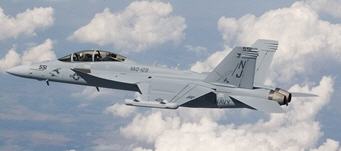
Under the heading of Cyberwar Spawns New Combat Aircraft, I learned that the military is building new 2 seat versions of the popular F/A-18, F-16, F-22, and even the F-15 fighter jets!
Even two aircrewmen may not be enough as cyber, intelligence and air combat commands have joined forces to promote new fighter designs that can conduct at least three missions at the same time.
New two-seat versions of the F/A-18, F-16, F-15C, F-15E and F-22 with advanced active, electronically-scanned array (AESA) radars will be expected to wind their way through enemy air defenses, invade networks, shoot down opposing aircraft and find very small targets and bomb them with precision.
Planners also see two-person crews as crucial in establishing local area networks so that in the event of nuclear, electronic or computer attacks (which could blackout command and control of today’s network centric forces) even a few of these aircraft could quickly begin communicating, gathering intelligence and counterattacking.
That's right, they're adding seats!
Huh. Who'd have thought?
Now, the important question here: Who can get me a ride in one of those jets? :-)
September 28, 2007
Bad Pilot Decisions: Three Emergency Landings in One Day!
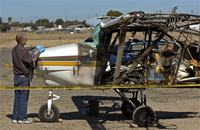 A few weeks ago this story caught my eye and I've been meaning to write about it ever since. A pilot (William Supan) flying his Piper Tri-Pacer from the Modesto Airport was taking a passenger (Jinhua Lin) for a first airplane ride. He had to make an emergency landing due to smoke coming out of the engine.
A few weeks ago this story caught my eye and I've been meaning to write about it ever since. A pilot (William Supan) flying his Piper Tri-Pacer from the Modesto Airport was taking a passenger (Jinhua Lin) for a first airplane ride. He had to make an emergency landing due to smoke coming out of the engine.
Upon landing, he apparently found a problematic hose clamp and went to the nearby Wal-Mart (not Wal-Mart Aviation Supply!) to get a replacement. He '"fixed" the problem himself, didn't get a mechanic to double-check his work, and went up again. As you might expect, the cockpit started to fill with smoke again, so he declared an emergency and landed a second time.
He checked and found that the hose had a cut in it. Apparently he replaced the hose (who knows what he used for that), because he took off a third time. But this time the engine caught fire and he made a third (and very bad) emergency landing. His passenger was spooked enough that she jumped from the plane on the runway and ended up in the hospital. That third landing cause substantial damage to the airplane (he bounced a few times and went off the runway), but the ensuing fire pretty much finished off the job.
Yikes!
In aviation safety training, it's often said that every accident is the result of a series of bad decisions, not just a single one. In this case, it's almost painful to read the story--seeing one bad decision after another, you can't help but to wonder what the guy was thinking.
I think The Modesto Bee story had a great line in it:
Ian Gregor of the FAA indicated that officials were surprised that pilot Wil-liam Supan, 52, of Pleasanton would try to take off a third time after having been forced to land twice because of smoke in the cockpit.
Hell, anyone with the smallest shred of common sense should have been surprised by that!
See Also: AVweb coverage
September 20, 2007
Instrument Flight (IFR) Training Ground School, Week #1: VFR Refresher
Last night I attended the first night of a 10 week course (3 hours for 1 night each week) to prepare for the FAA's Instrument Flight Rules (IFR) knowledge test. As part of reinforcing what we cover each week, I'm trying to write up a quick summary of each night's topics.
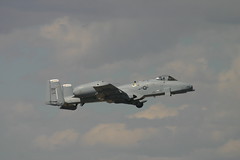 Sometimes typing things is a good way to refresh them in my own mind. Besides, you never know who might stumble onto this later and find it useful.
Sometimes typing things is a good way to refresh them in my own mind. Besides, you never know who might stumble onto this later and find it useful.
Introductions & Overview
Most of the first night was spend on introductions (meeting each other and our instructor), an overview of how the class will work, and some refreshers on various topics we all learned during our private pilot training.
Books
The main text for the course is the FAA's Instrument Flying Handbook which is available for free on-line. In addition, we're going to use the ASA Instrument Rating Test Prep for practice questions.
For additional reading, he suggested Jeppesen's Instrument/Commercial Manual and the FAA's Instrument Procedures Handbook. I'm told that those two do a better job of understanding the whole air traffic system and rationale behind why IFR operations work the way they doing.
Since I tend to remember things better when I understand why they work the way they do, I'm tempted to pick up those as well.
Finally, I have the King Schools Get It All Kit for the Instrument Rating. I've used their videos in the past and found them to be far superior to those from Sporty's.
VFR vs. IFR
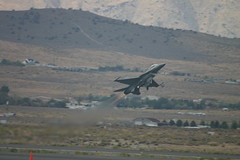 We spent a bit of time discussion the pros and cons of VFR vs. IFR flight, generating a list that looked something like this.
We spent a bit of time discussion the pros and cons of VFR vs. IFR flight, generating a list that looked something like this.
Pro IFR:
- Safety
- Charts have altitude info you need
- Get through weather
- Don't get stuck as often
Con IFR:
- Longer routes (takes more gas and time)
- Have to deal with controllers and radio
- Higher workload
Human Factors and Aeronautical Decision Making (ADM)
We spent a fair amount of time reviewing human factors, including medical issues, illusions, disorientation, night vision, and stress. We also talked about the FAA's IMSAFE (Illness, Medical, Stress, Alcohol, Fatigue, and Eats) self-assessment checklist.
In the real of ADM, we briefly recalled the FAA's DECIDE (Detect, Estimate, Choose, Identify actions, Do, Evaluate) model for dealing with situations. Everyone has to learn it, but few people actually think through it that way in reality.
Cockpit/Crew Resource Management (CRM)
Cockpit or Crew Resource Management is going to be a much more important skill to develop in IFR flight than our normal VFR operations. There's more paperwork in the cockpit, instruments to watch, and radio communication to deal with. So having a logical and predicatable system for organizing the physical objects (checklists, books, charts, flight plans, etc.) and other information is critical.
Having your flight plan handy is good for when the controller says "cleared as filed" rather than giving you a set of waypoints to copy down. :-)
Aerodynamics
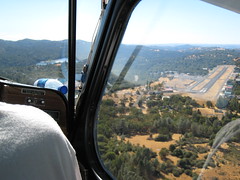 We concluded with a review of basic aerodynamics, including: indexing the airplane performance (for speeds and descent rates), angle of attack, flight path, pitch attitude, lift/drag/thrust/weight, and the various V speeds that come into play. We also talked a bit about the region of normal command and aircraft speed & pitch stability when using trim.
We concluded with a review of basic aerodynamics, including: indexing the airplane performance (for speeds and descent rates), angle of attack, flight path, pitch attitude, lift/drag/thrust/weight, and the various V speeds that come into play. We also talked a bit about the region of normal command and aircraft speed & pitch stability when using trim.
Other Stuff
I learned that following the VASI exactly at an airport will set you down at the 1,000 foot mark on most runways. That could be a very useful bit of trivia.
We also had chances to share stories about being, uh... surprised by weather in our flying.
September 11, 2007
Automated In-Flight Refueling of an F/A-18 Fighter Jet
This is one of the coolest things I've heard about in a while and I've been meaning to post about it for weeks now. You see, one of the trickiest thing that many fighter pilots have to learn (aside from carrier landings if you're in the Navy, that is) is how to re-fuel in the air.
Modern aircraft have incredibly capable autopilots that use a mix of GPS and inertial sensors to get a very accurate idea of where the plane is and where it is going. But re-fueling has always been a manual job--until now.
A DARPA project to figure out if computer could do the job has proven successful.
Sierra Nevada Corporation in Sparks, Nevada did most of the software work to tie in the optical sensors that fed into the navigation system (the "Autonomous Airborne Refueling Demonstration (AARD) system") once the jet was close enough to the fuel line. There's also an excellent write-up by the pilot in the front seat of that photo (the one with his hands up) in the current issue of Air & Space Magazine
Autonomous in-flight refueling. Who'd have thought?
September 05, 2007
Henry Coe State Park Fire Pictures
On Monday afternoon while flying back from Columbia (pictures), we noticed what looked like some dark clouds over the Diablo range. But as we started to cross the valley and go closer, it became clear that we were looking at a pretty good sized fire.
And, worse yet, I realized that if we wanted to fly straight back to Reid Hillview airport, we'd have to go through a lot of thick smoke.
So we diverted a bit to the north, flying over Tracy and Livermore before heading to San Jose. Along the way, we got a pretty good view of the fire and snapped the pictures you see here.
We were impressed by how close the fire is to to the Lick Observatory. They're probably not getting a very good view of the sky with this going on.
As of today, the fire in Henry Coe State Park is still burning rapidly and over 1,200 fire fighters are working to contain it.
August 23, 2007
Citabria, Champ, and Decathlon Flickr Photo Group
The other day I realized that there wasn't a Flickr Group dedicated to some of my favorite airplanes. So I created Citabria, Champ, and Decathlon on Flickr (a Yahoo service) as a group dedicated to pictures of the Aeronca, Bellanca, and American Champion tailwheel airplanes.
Of course, I'm a little biased since I own half of a 1969 Citabria 7KCAB (serial #181).
Anyway, if you're an owner, fan, or photographer of these birds, feel free to join the group and invite others :-)
August 20, 2007
A Lunch Flight to Half Moon Bay
On Sunday we decided that it was time to get back in the air again. After putting a new tailwheel spring chain on the airplane (the right one this time--last time it was the left), we headed out toward the south, aiming for Watsonville and ultimately the Pacific coast. The plan was to fly up the coast roughly 60 miles to Half Moon Bay Airport.
Before too long were we on the ground.
After arriving and tying the plane down at the far south end of the field, we walked through the path to the gate that leads to some of the nearby shops and restaurant. The nearest establishment to the airport is Mezzaluna, a nice little Italian place. They make a fantastic meat sauce.
We spent a bit of time walking by the ocean and checking out a few of the local shops before heading back to the airport for the flight back home. With full bellies, we decided to take out time and do a bit more sightseeing and photography along the way.
Along the way we got some excellent shots of the coast, including a lighthouse.
And the part I had most fun with was along the coast near Watsonville. We dropped down a few thousand feet, slowed the plane down, and put the camera out the window.
On the way home we swung by Frazier Lake Airport to play on their wonderful grass airstrip a bit.
Not a bad way to spend a Sunday afternoon! :-)
Full pictures are available here: Half Moon Bay Lunch Flight on Flickr.
July 08, 2007
In Parowan, Utah for the Week
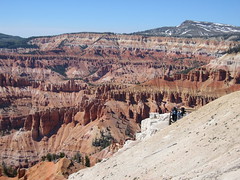 Much like two years ago, I'm on the road back to Parowan, Utah for a week of glider flying and visiting the Bryce Canyon and Zion National Park.
Much like two years ago, I'm on the road back to Parowan, Utah for a week of glider flying and visiting the Bryce Canyon and Zion National Park.
I drove to Bakersfield, California last night after picking up my glider from Hollister. In about an hour I'll set out on the roughly 8-9 drive from Bakersfield to Parowan, Utah where I'll be staying at Victoria's Bed and Breakfast for the week.
I'm basically on vacation for my last full flying week of the year (no pun intended, but time really is flying this year), so posting here will be light. But I'll try to get some interesting and/or amusing tidbits online.
Last time I went away for a week, Yahoo got a new CEO, so who knows what will happen this week...
See Also:
- Back From Utah (2005)
- Pictures frmo Cedar Breaks, Utah (2005)
- Benchmark Road and Recreation Maps (2005)
July 02, 2007
Glider Landing in Thunderstorm [video]
As promised, here's another video of a hairy glider landing. This one occurred when a Genesis 2 pilot came back to land at CCSC during a thunderstorm during a contest.
According to what I've read, he was getting bounced around quite a bit and hit a ton of sink right near the field. As you'll see, it was raining pretty hard and the field appeared to be soaked. That's part of what made the resulting ground loop pretty uneventful--well, that and the fact that the Genesis has a very small tail boom.
Other pilots who landed shortly before this one simply stayed in the gliders, partly to stay dry and partly to keep "flying" them if the wind kicked up.
Last season I witnessed a Genesis 2 pilot come back to Truckee as a storm approached and watched him almost not make the runway because of massive sink.
Yikes. Fly safe, guys...
